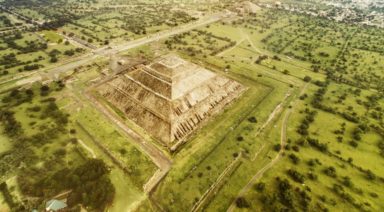Exploring the Ancient Pyramids of the World

If there is one structure that still gives rise to great amounts of interest, speculation and awe, it’s the ancient pyramids.
Oftentimes when we think of the pyramids, we concentrate our attention on the most famous –– the Egyptian pyramids so often featured in movies and travel magazines.
But there are actually many more pyramid locations other than Egypt, including Central America, China and beyond. You may be surprised by the varied places you can find pyramids across the world –– including underwater.
By delving into more pyramid facts, we can unlock more information and understanding about these sizable structures, their prominence throughout the world, and even their relevance for those throughout the world.
What Exactly is a Pyramid?
While you may have initially learned about the pyramid shape in geometry class, architectural pyramids are a bit more complex.
Generally the shape of pyramids include at least three outer triangular surfaces which join together at a point at the top, with the base being any number of shapes with multiple sides. This means that the base of a pyramid could be a square or other polygon.
Pyramids were generally built this way in order to distribute the majority of the weight closer to the ground, meaning less pressure coming from the top. This also allowed the builders of the pyramid to more easily constrict the structures using dry stone construction.
Pyramids in Ancient Civilizations
While the general pyramid structure generally remains the same, each civilization that constructed pyramids did so in a slightly different way. Let’s take a look at a few of the civilizations that lay claim to impressive ancient pyramids, and why each one is worth a closer look.
Egypt
The three famous ancient pyramids found in Egypt are what most people think of when they think of the pyramids. Current Egyptologists believe the Great Pyramid was constructed for Pharaoh Khufu, and is situated the furthest north.
Said to have been constructed in 2551 B.C., it used to measure about 147 meters, it now stands at around 137 meters, and contains more than 2 million blocks. The Great Pyramid was deemed one of the Seven Wonders of the World by the Greeks, and is the only one that has survived to the present day.
Another one of the over 100 pyramids in Egypt is the Pyramid of Djoser, built for his namesake the Pharaoh as a mausoleum. This pyramid is more of a step pyramid design, which involved six successively smaller layers and a flat top.
Mesopotamia
Of course, the pyramidal structures of Mesopotamia, or ziggurats, also deserve a nod for their place amongst the greatest pyramids of the world, as they were among the first to build them.
Many Mesopotamian groups built ziggurats, made of sun-dried mud-brick, although much of these structures have since deteriorated. Based on textual evidence, it appears that the multilayered structures built in Mesopotamia may have also had shrines at the top.
Perhaps one of the most significant of these ziggurats is the Ziggurat of Ur, located in what is today Ur, Iraq. The Ziggurat of Ur was built for the Sumerian king Ur-Nammu in the mid-21st century B.C. Though over time the structure eroded, it has been restored both in the 6th and 20th century.
Guatemala
On the other side of the globe, in what is today Guatemala, the ancient Mayan civilization left behind the pyramids of Tikal.
Since Tikal was such an important center for the Maya, it served as a natural place to put the pyramids. The tallest of these in Pyramid IV, which stands at about 65 meters. After the Maya abandoned the site, the pyramids were not found again for almost 800 years.
Today, these pyramids are now considered an UNESCO World Heritage Centre.
Largest Pyramids of the World
While there are different ways to determine which pyramids should claim the prize of largest pyramids of the world, some pyramid researchers have used basic geometrical formulas to do so. In other words, the length of base multiplied by the width and height, times one-third to arrive at the determination for the largest pyramid.
Based on those calculations, Ancient Explorers determined that the five largest pyramids are as follows:
- Bent Pyramid
- Red Pyramid
- Pyramid of Khafre
- Great Pyramid of Khufu
- Great Pyramid of Cholula
Does it call your attention that all but for the number one slot are located in Egypt?
Perhaps the most intriguing part about the Great Pyramid of Cholula, located about 50 miles southeast from Mexico City, is how hidden it is. If one didn’t know what they were looking for, they might just think that they had come across a large hill.
But the pyramid’s history remains shrouded in mystery. While it stood at four football fields wide upon completion (by an unknown people in that area of Mexico), an unknown something happened to it around 600 AD, resulting in much of it being destroyed.
Following inhabitants of the area attempted to restore and change it, but by the time the Spaniards arrived, it had succumbed to Mother Nature, masked by greenery and vegetation.
Hidden Pyramids Around the World
In addition to the many pyramids we know to exist, there are also many pyramids that may be hidden throughout the world. Among these places include:
- Bosnia – An amateur archaeologist has allegedly discovered the Pyramid of the Moon, believed to be the world’s oldest and largest step pyramid.
- China – Some Chinese archaeologists estimate that a hidden pyramid, located roughly 40 miles southwest of Xian, was constructed during the Hsia Dynasty between the years 2205 and 1767 B.C.
Exploring Additional Pyramid Theories
If these ancient pyramids and pyramid facts leave you wondering if there might be more to the story of pyramids and their role on the earth, you may want to dive a little deeper into the pyramid theories, including mathematical precision, secrets, and possible functions. Or, you may opt to build your own.
What else might your research reveal about pyramids? Likely much more than the movies would suggest.
Want more like this article?
Then don’t miss Ancient Civilizations on Gaia. Inside, we take you on a journey through Humanity’s suppressed origins and reveal the secret code left behind by our ancestors.
Laser Scanning Reveals Mayan Complex Hidden for Centuries

Laser mapping reveals nearly 500 ancient ceremonial sites hiding just under the landscape of modern-day Mexico and leads scientists to revise their understandings of the origins of the Maya Civilization.
Eastern Mexico is home to the ancient Maya, renowned for their striking pyramids, written language, and complex calendar system. It is there that scientists first discovered Aquada Fénix, the largest and oldest-known Mayan construction.
Professor Takeshi Inomata is an archeologist at the University of Arizona who led the study. “We did LiDAR, which is an airborne laser marking technique. Using this technique we found Aguada Fénix, which is the oldest monumental construction in the Maya area,” Inomata said. “It has a huge artificial plateau which has a perfect, rectangular shape measuring 1.4 km long and 400m wide, which represents the largest construction in the entire Maya history. It dates to probably 1,100 – 700 BC, which makes it the oldest monumental construction in the Maya area. So the interesting part is that the largest building happened at the very beginning or oldest stage of Maya civilization.”
Having made this extraordinary find, the team recently expanded their search to a broader area using the same cutting-edge LiDAR technology. They were specifically hoping to find sites built by the Olmec people, an older civilization thought to have influenced the development of the Maya. What LiDAR revealed was groundbreaking.
“We found nearly 500 ceremonial complexes, which look like Aguada Fénix, although they are not as big. This distribution shows they shared similar concepts of space, ritual, and probably worldview. It tells us the people in the Olmec area and the Maya area really exchanged ideas and that kind of interaction was very important for the initial development of Mesoamerican civilizations,” Inomata said.
“This is the earliest evidence for the gathering of a really large number of people. Those people probably did not have too many hierarchical organizations, they most likely did not have kings. They didn’t have much marked social inequalities, so those people gathered and organized themselves, then made these huge constructions. This really makes us think about the development and possibility of human societies, not just about Mesoamerica, but about human societies in general.”




































